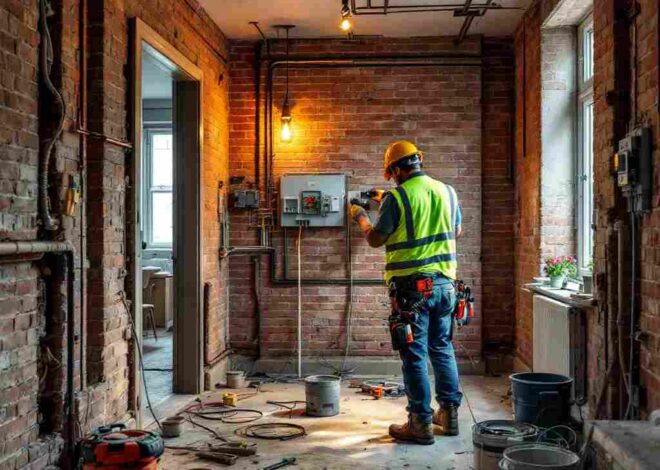
Expert Advice: Identifying and Correcting Electrical Problems in Older Homes
Are you living in an older home and experiencing electrical issues that just won’t seem to go away? You’re not alone. Many homeowners face challenges when it comes to identifying and correcting electrical problems in older homes. But fear not, because we’ve got expert advice to help you navigate through these issues with ease.
Introduction to the topic
Are you living in an older home and noticing some flickering lights or tripping circuits? It might be time to shine a light on the electrical issues lurking within your walls. In this blog post, we’ll dive into the world of identifying and correcting electrical problems in older homes, helping you navigate through potential shocks and sparks with ease. Let’s spark some knowledge on how to detect those pesky electrical issues before they escalate!
Understanding the common electrical problems in older homes
Older homes have a certain charm and character that many homeowners adore. However, with age comes the potential for electrical issues to arise. Understanding these common problems can help you tackle them effectively.
One prevalent issue in older homes is outdated wiring. Over time, wires can deteriorate or become damaged, leading to potential safety hazards. Keep an eye out for flickering lights, frequent tripped circuits, or burning smells near outlets as signs of wiring problems.
Another common problem is overloaded circuits. Older homes were not designed to handle the increased demand for electricity that modern appliances require. If you notice circuit breakers constantly tripping or dimming lights when using multiple devices simultaneously, your circuits may be overloaded.
Faulty outlets and switches are also frequent culprits in older homes. Loose connections or worn-out components can pose fire risks or cause electrical shocks if left unaddressed.
By understanding these common electrical issues in older homes, you can take proactive steps to ensure your home’s safety and functionality.
Signs to look out for to identify electrical issues in your home
Older homes have a certain charm and character that many homeowners find appealing. However, with age comes the potential for electrical issues to arise. It’s important to be vigilant and aware of signs that may indicate underlying problems within your home’s electrical system.
One common sign to look out for is frequent circuit breaker trips or blown fuses. If this happens often, it could indicate an overloaded circuit or faulty wiring. Another red flag is flickering or dimming lights when using appliances or electronics, suggesting inadequate power supply.
Keep an eye out for discolored outlets or switch plates, as this could point to overheating and potential fire hazards. Additionally, buzzing sounds coming from outlets or switches are not normal and should be investigated promptly by a professional electrician.
Don’t ignore any burning smells emanating from outlets or electrical panels; this could signal dangerous overheating. Lastly, if you experience mild shocks when touching appliances or switches, it’s crucial to address the issue immediately before it escalates into a more significant problem.
Steps to take when dealing with an electrical problem
Dealing with electrical problems in older homes can be daunting, but taking the right steps is crucial for your safety and the well-being of your property. When faced with an electrical issue, the first thing to do is always prioritize safety. Turn off the power to the affected area from the circuit breaker to prevent any accidents.
Next, gather essential tools like a voltage tester, wire strippers, and screwdrivers before attempting any troubleshooting. Always remember to wear insulated gloves and eye protection as an added precaution against electric shocks.
Identifying the root cause of the problem is key. Start by checking for visible signs of damage such as frayed wires or scorch marks near outlets or switches. If you’re unsure about how to proceed or if the issue seems complex, don’t hesitate to seek professional help immediately.
Remember, when it comes to dealing with electrical issues in older homes, caution and vigilance are your best allies in maintaining a safe living environment.
-
Safety precautions to follow
When dealing with electrical problems in older homes, safety should always be the top priority. Before attempting any troubleshooting or repairs, it is crucial to follow specific precautions to prevent accidents and injuries.
First and foremost, ensure that the power supply to the affected area is turned off before inspecting or working on any electrical components. This can be done by switching off the circuit breaker or removing the fuse connected to that particular section of your home.
It is advisable to wear insulated gloves and goggles while handling electrical wiring or outlets to protect yourself from potential shocks. Avoid using metal tools when working on live circuits as they can conduct electricity and pose a serious risk.
If you are unsure about how to safely troubleshoot an electrical issue, do not hesitate to seek professional help. Electricity can be extremely dangerous if mishandled, so it’s better to err on the side of caution when in doubt.
You may also read (exterior home painting projects diy or pro)
-
Tools and equipment needed
When it comes to identifying and correcting electrical problems in older homes, having the right tools and equipment is essential. Here are some key items you may need:
- Voltage tester: This tool helps you determine if a circuit is live or not, ensuring your safety before starting any work.
- Screwdrivers: Having a set of screwdrivers with different sizes and types will help you remove outlet covers, switches, and panels easily.
- Wire strippers: These are necessary for safely removing insulation from wires without damaging them.
- Circuit breaker finder: This device helps locate specific circuits in your home’s electrical panel, making troubleshooting easier.
- Insulation resistance tester: This tool can identify faulty insulation on wires that could lead to dangerous situations.
By having these tools readily available, you’ll be better equipped to tackle electrical issues in your older home effectively and safely.
-
How to troubleshoot the issue
When facing electrical issues in your older home, troubleshooting the problem is essential to ensure safety and prevent further damage. To start, switch off the power to the affected area at the circuit breaker. This step will help avoid any potential risks while you investigate.
Next, carefully inspect the outlets, switches, and wiring for any visible signs of damage such as frayed wires or scorch marks. Use a voltage tester to check if there is any current running through the components. If you’re not comfortable with this step, it’s best to seek professional help immediately.
Consider testing appliances on different circuits to determine if the issue lies within a specific area of your electrical system. Sometimes, a faulty appliance can cause disruptions that mimic larger problems within your home’s wiring.
Remember always to prioritize safety when troubleshooting electrical issues in older homes. If in doubt or unsure about how to proceed, do not hesitate to contact a licensed electrician for assistance and guidance throughout the process.
Common solutions for different types of electrical problems
Older homes often come with their fair share of electrical issues, but fear not, as there are common solutions to tackle these problems. One frequent culprit is wiring issues that may have deteriorated over time. In such cases, it’s crucial to inspect the wiring carefully and replace any damaged or outdated components.
Another prevalent problem in older homes is overloaded circuits due to increased power demands from modern appliances. To address this issue, consider redistributing the load on different circuits or installing additional outlets where needed.
Faulty outlets and switches can also cause headaches for homeowners. If you notice flickering lights or sparks when using certain outlets, it’s essential to replace them promptly to prevent potential hazards.
Remember, when dealing with electrical problems in older homes, safety should always be a top priority. By understanding these common solutions and taking proactive measures, you can ensure a safer and more efficient electrical system in your home.
-
Wiring issues
Wiring issues in older homes can be a common cause of electrical problems. Over time, the wiring may become worn out or damaged, leading to potential safety hazards. One sign to watch for is flickering lights or outlets that are not working properly.
If you suspect a wiring issue, it’s crucial to address it promptly. Start by turning off the power to the affected area and using a voltage tester to ensure no electricity is flowing. Inspect the wiring for any signs of fraying, melting, or damage.
In some cases, rewiring sections of your home may be necessary to resolve the issue safely and effectively. This task should always be handled by a qualified electrician to avoid any further complications. Taking proactive steps to address wiring issues can help maintain the safety and functionality of your home’s electrical system in the long run.
-
Overloaded circuits
Older homes often struggle to keep up with our modern-day electrical demands, leading to overloaded circuits. This issue occurs when too many appliances or devices are plugged into a single circuit, exceeding its capacity. The result? Potential fire hazards and damaged electronics.
To identify an overloaded circuit, pay attention to tripping breakers or blown fuses frequently. Dimming or flickering lights can also indicate this problem. When dealing with an overloaded circuit, start by unplugging unnecessary devices and redistributing the load across different circuits in your home.
Invest in power strips equipped with surge protectors to prevent overload situations. Consider upgrading your electrical panel if overloading is a persistent issue. Remember that safety should always come first when troubleshooting electrical problems like overloaded circuits in older homes!
-
Faulty outlets and switches
Faulty outlets and switches are common electrical issues that can pose serious risks in older homes. When you notice flickering lights, charred outlets, or outlets that feel warm to the touch, it could indicate a problem with these components.
To troubleshoot faulty outlets or switches, start by turning off the power to the affected area at the circuit breaker. Use a voltage tester to ensure there is no electricity flowing through before inspecting them for damage.
If you find any signs of burning or melting, it’s crucial to replace the outlet or switch immediately to prevent potential fires. Make sure to follow proper installation procedures and always use high-quality replacement parts.
In some cases, multiple outlets may be connected on the same circuit causing overload issues leading to faults. It’s essential to address these problems promptly and seek professional help if needed for safer solutions.
When to call a professional
While DIY troubleshooting can be helpful for minor electrical issues, there are times when it’s best to call in a professional electrician. If you encounter any of the following situations, do not hesitate to seek expert help:
- Persistent Electrical Problems: If you’ve attempted to fix an issue multiple times without success, it’s time to bring in a professional.
- Flickering Lights: Consistent flickering lights could indicate a more serious underlying problem that requires professional attention.
- Burning Smell or Sparks: Any burning smell or sparks coming from outlets or switches should be addressed immediately by a qualified electrician.
- Outdated Wiring: Older homes may have outdated wiring that poses safety hazards. A licensed electrician can assess and upgrade your electrical system accordingly.
Remember, electrical work can be dangerous if not handled properly. By knowing when to call a professional, you can ensure the safety and efficiency of your home’s electrical system for years to come. Stay safe and stay informed when dealing with electrical issues in older homes!
You may also read (comprehensive home inspections importance)


